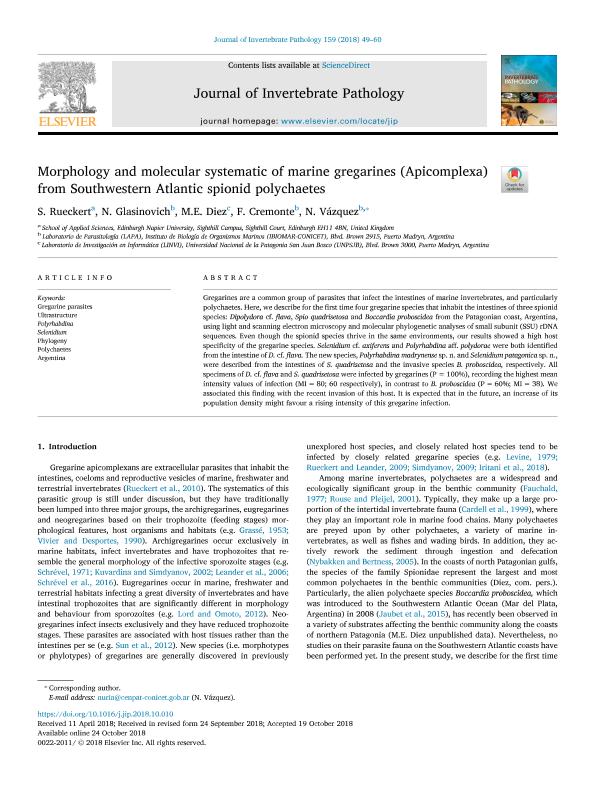Artículo
Morphology and molecular systematic of marine gregarines (Apicomplexa) from Southwestern Atlantic spionid polychaetes
Rueckert, S.; Glasinovich, Natusha Irina; Diez, María Emilia ; Cremonte, Florencia
; Cremonte, Florencia ; Vázquez, Nuria Natalia
; Vázquez, Nuria Natalia
 ; Cremonte, Florencia
; Cremonte, Florencia ; Vázquez, Nuria Natalia
; Vázquez, Nuria Natalia
Fecha de publicación:
11/2018
Editorial:
Academic Press Inc Elsevier Science
Revista:
Journal of Invertebrate Pathology
ISSN:
0022-2011
Idioma:
Inglés
Tipo de recurso:
Artículo publicado
Clasificación temática:
Resumen
Gregarines are a common group of parasites that infect the intestines of marine invertebrates, and particularly polychaetes. Here, we describe for the first time four gregarine species that inhabit the intestines of three spionid species: Dipolydora cf. flava, Spio quadrisetosa and Boccardia proboscidea from the Patagonian coast, Argentina, using light and scanning electron microscopy and molecular phylogenetic analyses of small subunit (SSU) rDNA sequences. Even though the spionid species thrive in the same environments, our results showed a high host specificity of the gregarine species. Selenidium cf. axiferens and Polyrhabdina aff. polydorae were both identified from the intestine of D. cf. flava. The new species, Polyrhabdina madrynense sp. n. and Selenidium patagonica sp. n., were described from the intestines of S. quadrisetosa and the invasive species B. proboscidea, respectively. All specimens of D. cf. flava and S. quadrisetosa were infected by gregarines (P = 100%), recording the highest mean intensity values of infection (MI = 80; 60 respectively), in contrast to B. proboscidea (P = 60%; MI = 38). We associated this finding with the recent invasion of this host. It is expected that in the future, an increase of its population density might favour a rising intensity of this gregarine infection.
Archivos asociados
Licencia
Identificadores
Colecciones
Articulos(IBIOMAR)
Articulos de INSTITUTO DE BIOLOGIA DE ORGANISMOS MARINOS
Articulos de INSTITUTO DE BIOLOGIA DE ORGANISMOS MARINOS
Citación
Rueckert, S.; Glasinovich, Natusha Irina; Diez, María Emilia; Cremonte, Florencia; Vázquez, Nuria Natalia; Morphology and molecular systematic of marine gregarines (Apicomplexa) from Southwestern Atlantic spionid polychaetes; Academic Press Inc Elsevier Science; Journal of Invertebrate Pathology; 159; 11-2018; 49-60
Compartir
Altmétricas



